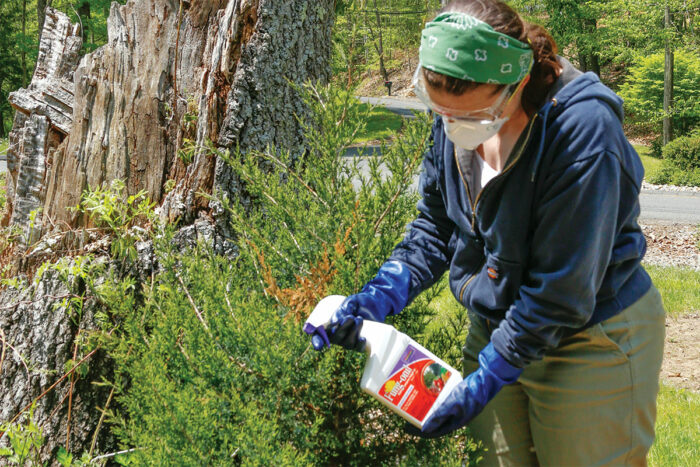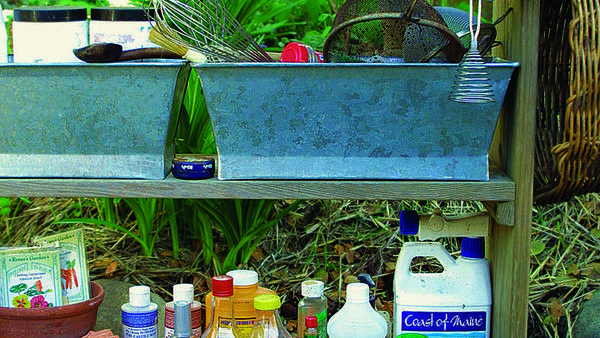
How you manage garden pests and diseases is a personal choice, and there are many management philosophies. Two of the most common methodologies are integrated pest management (IPM) and organic pest management. IPM was developed in the 1970s as a response to conventional gardening practices that relied heavily on pesticides. In contrast to those practices, IPM promoted sanitation, the use of disease- and pest-resistant plant varieties, and monitoring pest populations.
IPM also allows the use of synthetic pest- and disease-control chemicals in addition to any organically approved chemicals or management strategies. Some gardeners may find it surprising that synthetic pest and disease products are approved for use in IPM, but IPM does not dictate an organic-only approach. In contrast, strict organic pest and disease management prohibits the use of synthetic fertilizers or pesticides. What are the differences between organic and synthetic pest and disease products?
Learn more about treating common summer plant diseases
Organic Pest and Disease Products

The Organic Materials Review Institute (OMRI) is an independent nonprofit organization that evaluates products to determine if they comply with USDA standards for organic agriculture. Those products approved by OMRI for controlling powdery mildews and other diseases include sulfur, mineral oil, and neem oil. However, sulfur and oil must never be used at the same time or within 14 days of each other, as the combination can damage plants. Some formulations of copper fungicides are OMRI approved and labeled for organic control of many fungal and bacterial diseases. Biological controls containing microbes that suppress disease are also labeled for organic disease management.
Synthetic Pest and Disease Products
The following synthetic pest and disease products are not approved by OMRI for organic agriculture, but they could be used as part of an integrated pest management approach. There are quite a few synthetic fungicides available for home use, including captan for fruit production. Fungicides containing tebuconazole or propiconazole provide targeted protection against many common plant diseases such as apple scab, rose black spot, rust, and powdery mildew. Phosphorous acid fungicides are highly effective against Phytophthora, Pythium, and downy mildews.
Choosing Between Synthetic and Organic Products
In choosing a product, many factors come into play. Before applying, verify that the product will work on the problem, how often it needs to be used, and how safe it is to the applicator and to other people and pets. Note that any product used incorrectly is not safe, regardless of whether it is organic or synthetic.
HOW TO
Work Safely with Organic or Synthetic Fungicides
If cultural management practices are not enough to prevent or control a fungal disease, you may decide to turn to chemical controls. Before you buy a product, familiarize yourself with the safety precautions you will need to follow when using it. Here are some pointers to help keep you and your garden’s ecosystem as safe as possible.
- Confirm that your diagnosis is correct
Applying a fungicide when no fungal disease is present can do more harm than good. If you are not 100% sure of your diagnosis, reach out to your local Cooperative Extension System (CES) office or Master Gardener program for assistance.
- Assemble your PPE
Before you start, read the product safety guidelines carefully and make sure you have the proper attire and personal protective equipment (PPE). Recommended precautions often include wearing long sleeves and long pants, gloves, eye protection, and respiratory protection. Keep pets, children, and anyone not wearing proper PPE out of the area while you are applying the product.
- Avoid unnecessary exposure
Choosing a ready-to-use product rather than a concentrate minimizes the need to handle and mix potent chemicals. Timing is important too. Applying a fungicide at the wrong point in a pathogen’s life cycle will create an environmental impact without fixing the problem.
Janna Beckerman is a professor and extension plant pathologist in Purdue University’s Department of Botany and Plant Pathology in West Lafayette, Indiana.


















Comments
Log in or create an account to post a comment.
Sign up Log in